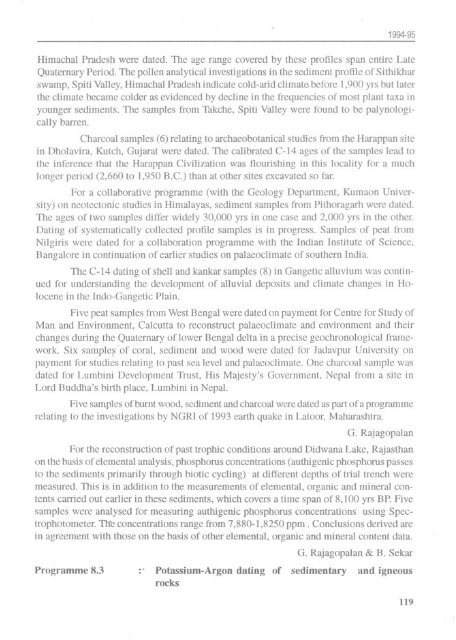1994-95 - Birbal Sahni Institute of Palaeobotany
1994-95 - Birbal Sahni Institute of Palaeobotany
1994-95 - Birbal Sahni Institute of Palaeobotany
You also want an ePaper? Increase the reach of your titles
YUMPU automatically turns print PDFs into web optimized ePapers that Google loves.
<strong>1994</strong>-<strong>95</strong><br />
Himachal Pradesh were dated. The age range covered by these pr<strong>of</strong>iles span entire Late<br />
Quaternary Period. The pollen analytical investigations in the sediment pr<strong>of</strong>ile <strong>of</strong> Sithikhar<br />
swamp, Spiti Valley, Himachal Pradesh indicate cold-arid climatB before 1,900 yrs but later<br />
the climate became colder as evidenced by decline in the frequencies <strong>of</strong> most plant taxa in<br />
younger sediments. The samples from Takche, Spiti Valley were found to be palynologically<br />
barren.<br />
Charcoal samples (6) relating to archaeobotanical studies from the Harappan site<br />
in Dholavira, Kutch, Gujarat were dated. The calibrated C-14 ages <strong>of</strong> the samples lead to<br />
the inference that the Harappan Civilization was flourishing in this locality for a much<br />
longer period (2,660 to 1,<strong>95</strong>0 B.C.) than at other sites excavated so far.<br />
For a collaborative programme (with the Geology Depattment, Kumaon University)<br />
on neotectonic studies in Himalayas, sediment samples from Pithoragarh were dated.<br />
The ages <strong>of</strong> two samples differ widely 30,000 yrs in one case and 2,000 yrs in the other.<br />
Dating <strong>of</strong> systematically eolleeted pr<strong>of</strong>ile samples is in progress. Samples <strong>of</strong> peat from<br />
Nilgiris were dated for a collaboration programme with the Indian <strong>Institute</strong> <strong>of</strong> Science,<br />
Bangalore in continuation <strong>of</strong> earlier studies on palaeoelimate <strong>of</strong> southern India.<br />
The C-14 dating <strong>of</strong> shell and kankar samples (8) in Gangetic alluvium was continued<br />
for understanding the development <strong>of</strong> alluvial deposits and climate changes in Holocene<br />
in the Indo-Gangetie Plain.<br />
Five peat samples from West Bengal were dated on payment for Centre for Study <strong>of</strong><br />
Man and Environment, Caleutta to reconstlUct palaeoclimate and environment and their<br />
changes during the Quaternat·y <strong>of</strong> lower Bengal delta in a precise geochronological framework.<br />
Six sample~ <strong>of</strong> coral, sediment and wood were dated for Jadavpur University on<br />
payment for studies relating to past sea level and palaeoclimate. One charcoal sample was<br />
dated for Lumbini Development Trust, His Majesty's Government, Nepal from a site in<br />
Lord Buddha's birth place, Lumbini in Nepal.<br />
Five samples <strong>of</strong>bmnt wood, sediment and ehat·eoal were dated as palt <strong>of</strong> a programme<br />
relating to the investigations by NGRI <strong>of</strong> 1993 eaIth quake in Latoor, MahaI·ashtra.<br />
G. Rajagopalan<br />
For the reconstruetion <strong>of</strong> past trophic conditions around Didwana Lake, Rajasthan<br />
on the basis <strong>of</strong> elemental analysis, phospholUS eoncentrations (authigenic phospholUs passes<br />
to the sediments primarily through biotic cycling) at different depths <strong>of</strong> trial trench were<br />
measured. This is in addition to the measurements <strong>of</strong> elemental, organic and mineral eontents<br />
carried out earlier in these sediments, which covers a time span <strong>of</strong> 8, 100 yrs BP. Five<br />
samples were analysed for measuring authigenic phospholUs concentrations using Spectrophotometer.<br />
We concentrations range from 7,880-1,8250 ppm . Conclusions derived are<br />
in agreement with those on the basis <strong>of</strong> other elemental, organic and mineral content data.<br />
G. Rajagopalan & B. SekaI·<br />
Programme 8.3 Potassium-Argon dating <strong>of</strong> sedimentary and igneous<br />
rocks<br />
119

















